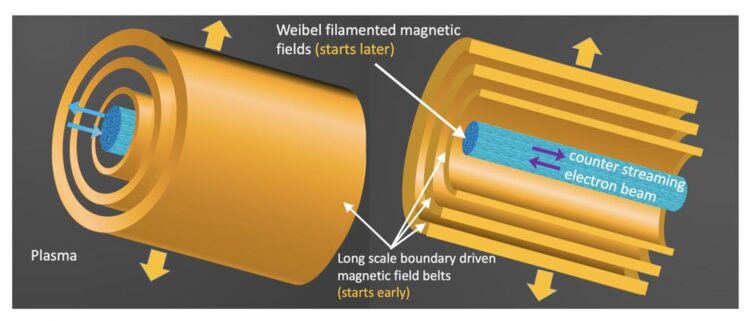Magnetic field with the edge!

Magnetic field in beam-plasma interaction: The field begins at the beam boundary and is larger than that in the bulk.
Credit: Ratan Bera
A team of Indian and Japanese physicists have overturned the six-decade old notion that the giant magnetic field in a high intensity laser produced plasma evolves from the small, nanometre scale in the bulk plasma [1]. They show that instead the field actually originates at macroscopic scales defined by the boundaries of the electron beam that is propagating in the plasma. The new mechanism seeks to alter our understanding of magnetic fields in astrophysical scenarios and laser fusion and may help in the design of the next generation high energy particle sources for imaging and therapies.
Giant magnetic fields billion times that of the earth, exist in the hot, dense plasma in astrophysical systems like neutron stars [2]. Basic electromagnetism established from the times of Oersted and Faraday tells us that it is the current in a system that causes magnetic fields. In a plasma there are two currents, one a forward propagating one and an opposite, mitigating current induced by the forward one itself.
If the currents are equal and overlapped in space, there is no net magnetic field. However, small fluctuations in the plasma can separate them and lead to an instability that grows with time. Indeed, for decades it has been believed that the giant fields arise from the interaction of opposing currents inside the bulk plasma via the famous Weibel instability [3], at scales much smaller than the beams themselves. The magnetic field is then said to spread out to macroscopic space via what is called an inverse cascade, in a ‘bottom up’ fashion.
In contrast, the India-Japan team shows that the field actually originates at the boundary of the current beam that is at macroscopic length scales and moves inwards to smaller scales (top down!). And the magnitude of this field is much larger than that caused by Weibel and other instabilities. The team christens the mechanism leading to this magnetic field ‘finite beam mechanism’ to indicate the crucial role of the finite size of the current beam in this mode. They show that radiation leaks out of the edges of the current destabilizing the beam and causing the magnetic field. There is clear evidence for this mode in their laser experiments and computer simulations.
Why has this new mode been missed in all the computer simulations over the past many decades? The authors point out that this is due to the assumptions of homogeneity and infinite extent typical of all simulations. However, real physical system have boundaries and the physics there leads to several interesting effects — examples are the focusing of charged particles by the fringe fields at the end of capacitor plates, the famous Casimir effect that leads to attraction between the plates due to quantum effects, and the surface propagating electromagnetic modes known as surface plasmons, quite popular in nano-optics and near field microscopies.
Caution! Tread carefully at the edge.
References:
[1] A. Pukhov, Strong field interaction of laser radiation, Rep. Prog. Phys. 66 (2003) 47-101
[2] For example, see https:/
[3] E. S. Weibel, Spontaneously Growing Transverse Waves in a Plasma Due to an Anisotropic Velocity Distribution, Phys. Rev. Lett. 2, 83 (1959)
Media Contact
All latest news from the category: Physics and Astronomy
This area deals with the fundamental laws and building blocks of nature and how they interact, the properties and the behavior of matter, and research into space and time and their structures.
innovations-report provides in-depth reports and articles on subjects such as astrophysics, laser technologies, nuclear, quantum, particle and solid-state physics, nanotechnologies, planetary research and findings (Mars, Venus) and developments related to the Hubble Telescope.
Newest articles

Sea slugs inspire highly stretchable biomedical sensor
USC Viterbi School of Engineering researcher Hangbo Zhao presents findings on highly stretchable and customizable microneedles for application in fields including neuroscience, tissue engineering, and wearable bioelectronics. The revolution in…

Twisting and binding matter waves with photons in a cavity
Precisely measuring the energy states of individual atoms has been a historical challenge for physicists due to atomic recoil. When an atom interacts with a photon, the atom “recoils” in…

Nanotubes, nanoparticles, and antibodies detect tiny amounts of fentanyl
New sensor is six orders of magnitude more sensitive than the next best thing. A research team at Pitt led by Alexander Star, a chemistry professor in the Kenneth P. Dietrich…





















